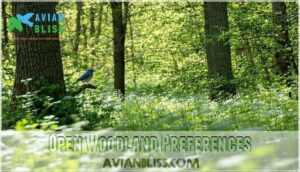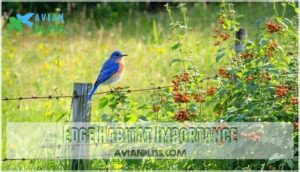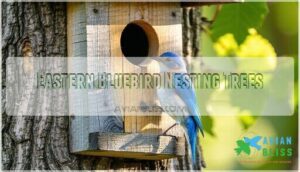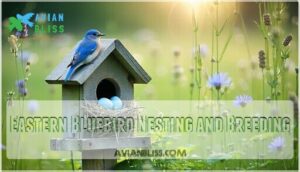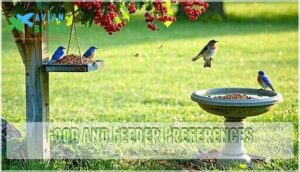This site is supported by our readers. We may earn a commission, at no cost to you, if you purchase through links.
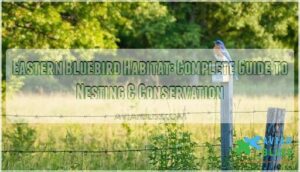
Edge habitats where forests meet fields create ideal hunting grounds for their "scan-and-swoop" technique. Thanks to nest box programs, these once nearly-extinct beauties have bounced back remarkably. There’s more to creating the perfect bluebird sanctuary than you might expect.
Table Of Contents
- Key Takeaways
- Eastern Bluebird Habitat Requirements
- Eastern Bluebird Nesting Trees
- Eastern Bluebird Migration Patterns
- Eastern Bluebird Diet and Foraging
- Eastern Bluebird Nesting and Breeding
- Eastern Bluebird Conservation Status
- Attracting Eastern Bluebirds to Your Yard
- Eastern Bluebird Behavior and Social Structure
- Eastern Bluebird Climate Vulnerability
- Eastern Bluebird Interesting Facts
- Frequently Asked Questions (FAQs)
- Do blue birds mate for life?
- Do Bluebirds stay in Ohio in the winter?
- Are eastern bluebirds threatened?
- How do I attract Eastern Bluebirds to my yard?
- What trees do Eastern Bluebirds nest in?
- Do bluebirds come back to the same nest every year?
- Where do Eastern Bluebirds go in the winter?
- How do eastern bluebirds adapt to urban environments and parks?
- Can eastern bluebirds be found in mountainous regions and elevations?
- How do eastern bluebirds interact with other bird species and predators?
- Conclusion
Key Takeaways
- Focus on open areas with scattered trees and minimal shrubs if you want to attract eastern bluebirds—they hunt best with plenty of perches and space to spot insects.
- Install nest boxes or use dead trees with natural cavities for bluebirds to raise young, and make sure the location’s open with clear flight paths in mind.
- Plant native berry-producing shrubs like sumac and elderberry to give bluebirds critical food during colder months when insects are scarce.
- Maintain edge habitats where fields meet woods, since these transitions offer bluebirds the best mix of food, nesting sites, and protection from predators.
Eastern Bluebird Habitat Requirements
You’ll find eastern bluebirds thrive in open areas with scattered trees, minimal understory, and plenty of perching spots like fence posts or power lines.
These habitat requirements aren’t just preferences—they’re essential for their "scan-and-swoop" hunting style that helps them catch insects on the ground below.
Open Woodland Preferences
When you’re creating the perfect Eastern Bluebird habitat, you’ll want to focus on open woodland areas where these charming birds can thrive like nature intended. Eastern Bluebirds prefer habitats with low woodland canopy density and minimal understory composition, giving them clear flight paths for insect hunting. These edge effects between forests and fields create ideal foraging habitat where bluebirds can spot prey from their perches.
Your Eastern Bluebird habitat should feature:
- Scattered trees with 30-50% canopy cover for prime breeding habitat
- Low shrub density allowing easy access to ground-dwelling insects
- Tree species diversity including oaks and pines for natural cavities
- Berry-producing plants like elderberry and sumac for winter food
- Minimal habitat fragmentation connecting woodland patches together
Think of it as creating a bird’s version of a suburban neighborhood—not too crowded, but with enough trees for shelter and plenty of open space for hunting.
Nesting Site Selection
Eastern Bluebird nesting success depends on finding the perfect cavity. You’ll want to look for entrance holes measuring 1.5 inches in diameter—just right for competition avoidance while keeping larger birds out.
These cavity nesters show considerable site fidelity, often returning to successful nest boxes year after year. When choosing nesting locations, bluebirds prefer boxes facing east or southeast for morning warmth while avoiding afternoon heat.
Edge Habitat Importance
Three key factors make edge habitats absolutely indispensable for Eastern Bluebird survival. These transitional zones where forests meet fields create perfect conditions that single habitats can’t match. You’ll find bluebirds thriving along woodland borders, farm edges, and suburban boundaries where different ecosystems blend together.
Here’s why these boundary areas foster thriving Eastern Bluebird populations:
- Biodiversity Benefits: Edge habitats host diverse insect communities, providing abundant prey like beetles and grasshoppers that make up 68% of breeding season diets.
- Microclimate Effects: These zones create varied temperature and moisture conditions, extending foraging seasons and fostering berry-producing plants year-round.
- Species Interactions: Reduced competition occurs here compared to dense forests, while maintaining protective cover from predators.
- Conservation Strategies: Habitat fragmentation paradoxically benefits bluebirds by creating more edge environments, though connecting these areas remains indispensable for population stability.
Understanding these foraging and nesting requirements helps explain why thoughtful landscape management fostering edge habitats proves essential for Eastern Bluebird conservation success.
Backyard Habitat Creation
Transform your yard into an Eastern Bluebird Habitat paradise! Plant Native Plants like elderberry and berry-producing plants to meet their Foraging and Nesting Requirements.
Add Water Sources and create Roosting Spots with dense shrubs. Practice Chemical Reduction by avoiding pesticides.
Install proper Nest Box Installation with predator guards. These Shelter Creation efforts foster Backyard Birdwatching while meeting bluebirds’ habitat needs.
Eastern Bluebird Nesting Trees
You’ll find that Eastern Bluebirds aren’t picky about their tree homes, but they do have clear favorites regarding nesting spots. Oak and pine trees often provide the perfect woodpecker holes and natural cavities these birds need.
Though they’re just as happy to move into a well-placed nest box that mimics nature’s design.
Oak and Pine Tree Preferences
Stability is key to the nesting success of Eastern Bluebirds. Oak abundance plays a vital role, as these trees develop natural cavities over decades, providing ideal breeding habitats. Mature oaks, through weathering and insect activity, form perfect nesting holes. Nearby, pine density offers excellent foraging grounds, with bluebirds hunting insects from their sturdy branches.
Tree age is crucial. Older oaks are particularly valuable for their cavity formation, a feature Eastern Bluebirds rely on. Mature pines, with their textured bark, shield nests from wind and rain. Eastern Bluebirds show a clear preference for:
- Established oak groves with multiple cavity options for raising broods
- Dense pine stands that shelter nests from harsh weather conditions
- Mixed woodlands combining both species for breeding habitat
- Mature trees over 20 years old with natural weathering patterns
- Healthy specimens that foster abundant insect populations for feeding
When planted together, oaks and pines create the perfect Eastern Bluebird habitat. They provide nesting sites and support berry-producing plants beneath their canopy, further enhancing the environment for these birds.
Burn Scars and Woodpecker Holes
While oak and pine provide excellent nesting opportunities, you’ll find Eastern Bluebirds equally drawn to burn scars and abandoned woodpecker holes. Fire ecology creates perfect cavity creation sites, as burn scars offer naturally hollowed spaces that bluebirds readily adopt. These scar benefits include ideal nesting competition reduction since other species often avoid fire-damaged areas.
Woodpecker holes from Pileated, Red-headed, and Downy species become prime Eastern Bluebird habitat once abandoned. Through habitat succession, these cavity nesting and roosting sites help Eastern Bluebirds live successfully in both foraging habitat and breeding habitat environments.
Dead Tree Selection
While healthy snags make prime breeding habitat, you’ll want to choose dead trees at specific Decay Stages for peak Snag Suitability. Look for moderately decayed specimens where Tree Species like oak and pine still maintain structural integrity. Cavity Size should accommodate bluebird dimensions, and Location Matters for both foraging habitat access and predator protection.
Key selection criteria:
- Firm outer shell with softened interior wood
- Natural cavities 1.5-1.75 inches in diameter
- Standing snags 5-20 feet high in open areas
Nest Box Installation
Since Eastern Bluebird conservation depends on proper nest box installation, you’ll want to get the details right. These birdhouses become key nesting boxes in human-created environments where natural cavities are scarce.
Here’s your installation checklist:
- Box Placement: Mount 5-8 feet high facing southeast, away from prevailing winds and afternoon heat.
- Hole Size and Materials: Use cedar or pine boxes with 1.5-inch entrance holes to exclude larger competitors.
- Predator Guards and Monitoring Protocol: Install metal guards below boxes and check weekly during breeding season for successful occupancy.
Proper installation transforms ordinary backyards into thriving Eastern Bluebird habitats.
Eastern Bluebird Migration Patterns
You might be surprised to learn that not all Eastern Bluebirds pack their tiny suitcases and fly south; some stick around, braving winter with just a few extra feathers and a determined attitude.
By following their seasonal journeys, you’ll notice patterns shaped by food, weather, and, occasionally, a stubborn bluebird that simply refuses to leave its favorite perch.
Partial Migration Explained
Eastern Bluebird migration isn’t an all-or-nothing affair. Some populations migrate while others stay put year-round, creating fascinating population differences.
Environmental cues like temperature drops and food scarcity trigger migration in northern birds, while genetic factors influence which individuals respond to these signals.
During the nonbreeding season, you’ll find migratory Eastern Bluebirds mixing with resident populations, creating complex bluebird migration patterns that vary greatly across their range.
Wintering Grounds Location
During the nonbreeding season, Eastern Bluebirds live in southern habitats based on migration distance from breeding grounds. Northern populations travel furthest, while southern birds often stay year-round where food availability and climate factors help survival.
Key wintering locations include:
- Gulf Coast states with abundant berry-producing plants
- Mexico’s pine-oak forests offering ideal Roosting Sites
- Southern Arizona’s desert grasslands
- Florida’s open woodlands and agricultural areas
Understanding Bluebird Migration Patterns helps predict where you’ll spot these beauties during colder months.
Migration Timing and Routes
You’ll notice Migration Triggers like daylight changes and temperature drops signal departure time for Eastern Bluebirds (Sialia sialis). These birds show strong Route Fidelity, following familiar paths year after year.
Weather Influence can delay or accelerate travel, while Stopover Ecology provides important rest stops.
Their Navigation Methods rely on magnetic fields and landmarks during Breeding and Nonbreeding Seasons transitions.
Climate Change Impacts
While you’ve learned about timing and routes, climate change is now rewriting the playbook for Eastern Bluebirds (Sialia sialis). Rising temperatures are forcing these birds to adapt in ways that would have seemed impossible just decades ago. Eastern bluebird populations have declined by 1.14% per year, and the eastern bluebird may shift its range over time due to these increased energy costs to areas with more favorable thermal conditions.
Unfortunately, Eastern Bluebirds live in an increasingly unpredictable world where their traditional patterns no longer guarantee success. As it turns out, research indicates a southward shift in maximum breeding latitude for bluebirds.
Here’s what’s happening to their migration patterns:
- Habitat Shifts: Eastern Bluebird behavior now includes moving farther north as warmer temperatures push their comfort zone beyond historical boundaries.
- Food Availability: Extreme weather disrupts insect emergence, creating mismatches between when chicks need food and when it’s available.
- Range Changes: Both breeding and nonbreeding seasons are shifting as birds seek cooler climates and suitable nesting sites.
Mitigation strategies like strategic nest box placement and habitat conservation can help these resilient birds weather climate uncertainty.
Eastern Bluebird Diet and Foraging
You’ll watch eastern bluebirds use a "scan-and-swoop" hunting style that’s surprisingly effective, perching on fence posts and power lines before dropping down to snatch insects from the ground.
During summer months, about 68% of their diet consists of beetles, grasshoppers, and caterpillars, but they’ll switch to berries and fruits when cold weather arrives and bugs become scarce.
Insect Prey Preferences
When you watch Eastern Bluebirds hunt, you’ll see their larval consumption tactics shine. These birds target beetle varieties, caterpillars, and crickets with precision. Grasshopper importance peaks during summer months, while spider predation increases in spring.
Their feeding habits show striking seasonal variation. The Eastern Bluebird diet shifts from 68% insects during breeding to mixed prey in winter, demonstrating their adaptable bluebird diet strategies.
Berry Consumption
During winter months, Eastern Bluebirds rely heavily on berry nutrition for survival. Seasonal availability drives their berry preferences, with seed dispersal benefiting both birds and plants.
Here are 4 favorite berries Eastern Bluebirds eat:
- Sumac berries: Rich winter fuel source
- Juniper berries: Cold-weather survival essential
- Dogwood berries: High-energy autumn treat
- Wild grape clusters: Sweet late-season favorites
Foraging Techniques
Eastern Bluebirds master scan-and-swoop techniques, perching 2-49 feet high before diving groundward for insects. Their feeding behavior includes prey identification from elevated perches, then swift aerial catches.
Cooperative foraging occurs during winter flocks. Seasonal variation shifts focus from summer insects to autumn berries.
Urban foraging adapts these natural hunting skills to suburban environments.
Feeder Visitation
Why don’t Eastern Bluebirds eat at feeders like other songbirds? Actually, they do visit feeders with proper setup and food. These cavity-nesters show seasonal variation in feeding behavior, preferring insects during breeding season but accepting supplemental foods in winter.
- Feeder types: Use platform feeders or shallow dishes for mealworms and suet
- Food preferences: Offer dried mealworms, suet, and native berries over seeds
- Feeder placement: Position feeders near nest boxes and open perching spots
- Competitor species: House Sparrows and European Starlings may dominate feeders
- Bird feeding timing: Morning visits are most common when insects are scarce
Eastern Bluebird Nesting and Breeding
You’ll discover that Eastern Bluebirds start their breeding journey by selecting nest cavities in early spring, with males arriving first to claim prime real estate like old woodpecker holes or your carefully placed nest boxes.
Once paired up, these devoted parents work together through multiple broods each season, turning simple grass-lined cavities into bustling nurseries where pale blue eggs transform into fledgling acrobats ready to explore their open habitat world.
Nest Placement and Description
Finding the perfect spot comes down to cavity size preferences and nest site competition. Eastern Bluebirds scout natural cavity options like old woodpecker holes or nest boxes you’ve installed. The female picks nesting material choice carefully, weaving grasses into a cozy cup.
| Feature | Natural Cavities | Nest Boxes |
|---|---|---|
| Entrance Size | 1.5 inches diameter | 1.5 inches diameter |
| Interior Dimensions | 4x4x8 inches deep | 5x5x8 inches deep |
| Height Placement | 3-20 feet high | 4-6 feet ideal |
| Competition Level | High with other birds | Manageable with proper spacing |
Egg Laying and Incubation
Once your bluebird pair has prepared their nest, the female begins her egg laying routine. She’ll deposit one pale blue egg daily until her clutch size reaches 3-5 eggs. The female takes care of incubation duties solo, keeping eggs at a steady 99°F for about 13-14 days. Her dedication pays off with impressive hatching success rates when conditions are right.
- Egg coloration: Pale blue eggs provide natural camouflage in cavity nests
- Incubation period: Female maintains constant temperature through body contact
- Parental roles: Male guards territory while female focuses on incubation
Parental Care and Fledging
Both parents share chick feeding duties, delivering insects every few minutes to hungry nestlings. You’ll observe fascinating parental roles – males focus on brood defense while females handle nest sanitation. After 18-19 days, fledglings leave but depend on parents for another week, learning essential bird behavior and nesting habits before achieving fledgling independence.
| Parental Task | Responsibility |
|---|---|
| Chick Feeding | Both parents deliver insects continuously |
| Nest Sanitation | Female removes waste, maintains cleanliness |
| Brood Defense | Male guards territory, warns of predators |
Breeding Season Timing
Once young bluebirds successfully fledge, timing becomes everything for the next breeding cycle. Eastern Bluebirds mate from March through July, with clutch initiation varying by regional variation and temperature influence. Resource availability drives brood frequency decisions in their breeding habitat.
Here’s what affects bluebird nesting timing:
- Early season pairs begin courtship display rituals when temperatures consistently reach 50°F
- Peak nesting habits occur during May and June when insect populations explode
- Late broods depend on food abundance, with some pairs attempting third clutches
Eastern Bluebird Conservation Status
You’ll find that Eastern Bluebirds went from nearly disappearing in the mid-1900s to making one of conservation’s greatest comeback stories.
Thanks to dedicated volunteers installing nest boxes across North America, their population has grown by over 1.5% annually since 1966, proving that simple actions can create big changes for wildlife.
Simple nest box programs helped Eastern Bluebirds recover from near extinction to thriving populations growing 1.5% annually
Historical Decline and Recovery
Eastern Bluebird populations once faced a dramatic Population Bottleneck during the mid-20th century. You’d be surprised how severely DDT Impact and habitat loss nearly wiped them out. Invasive Competition from House Sparrows and European Starlings made things worse by stealing their breeding habitat.
| Challenge | Solution |
|---|---|
| DDT poisoning | Chemical bans |
| Nest site loss | Nest Box Programs |
| Invasive species | Habitat management |
Fortunately, Eastern Bluebird recovery became a conservation success story. Nest Box Programs launched by dedicated volunteers created thousands of Human-created Environments perfect for nesting. Citizen Science efforts helped monitor populations, and today Eastern Bluebirds are thriving again thanks to ongoing Bluebird Conservation initiatives, which include addressing Invasive Competition and promoting Nest Box Programs.
Current Conservation Efforts
Today’s conservation success story unfolds through dedicated efforts nationwide. Nest box programs lead the charge, with over 500 monitored boxes in Pennsylvania alone helping Eastern Bluebirds thrive. One such initiative is the Bluebirds Nesting Box Program which focuses on bolstering local populations.
- Nest box programs – Volunteers maintain thousands of nesting boxes, boosting fledgling survival rates through proper placement and predator baffles
- Habitat restoration – Projects create ideal open woodlands with scattered trees and low-cut grass areas
- Citizen science partnerships – Data from 300+ contributors tracks 140,000 fledglings, informing bluebird conservation strategies
Threats and Challenges
While conservation efforts have helped restore populations, Eastern Bluebirds still face serious challenges. Pesticide use continues to poison insects, reducing their primary food source. Invasive species like European Starlings outcompete bluebirds for nesting sites, while habitat loss from development eliminates berry-producing plants.
Here’s what they’re up against:
| Threat Type | Impact on Eastern Bluebirds |
|---|---|
| Environmental | Climate change affects insect availability |
| Human-created | Development destroys nesting habitat |
| Predation Risks | Cats and raccoons threaten adults/young |
Conservation Organizations
Multiple organizations champion bluebird conservation through research initiatives and habitat preservation efforts. The North American Bluebird Society leads volunteer opportunities nationwide, while state groups provide local funding sources.
Join these dedicated groups to contribute to public awareness campaigns and birdwatching tips that help Eastern Bluebirds thrive.
- Connect with bluebird societies offering nest box installation programs and Bird Nesting Guide resources
- Participate in citizen science projects that track population trends across breeding territories
- Back organizations providing educational materials about creating ideal habitat for bluebirds
Attracting Eastern Bluebirds to Your Yard
You can transform your backyard into a bluebird haven with just a few strategic changes that mimic their natural habitat preferences.
Installing proper nest boxes, planting native berry-producing shrubs, and maintaining open lawn areas with scattered perches will create an irresistible invitation for these colorful cavity nesters to call your yard home.
Food and Feeder Preferences
Conservation efforts have given Eastern Bluebirds a second chance, but they still need your help through proper feeding. You’ll want to stock up on insect mealworms as their top choice, since these protein-packed treats fuel their bird diet naturally.
Suet feeders work great during winter months, while berry-producing plants provide essential winter berries year-round. Skip preferred seeds – bluebirds rarely eat them. Fresh water sources complete the picture for Project FeederWatch success.
Nest Box Installation and Maintenance
When selecting the perfect spot for your nest box, choose locations 5-6 feet high with morning sun exposure and open flight paths. Install predator guards below boxes to deter climbing threats.
Choose cedar or pine construction for weather resistance. Clean boxes annually after breeding season ends, removing old nesting materials completely.
Monitor weekly during nesting season, checking from a respectful distance to avoid disturbing bluebird families in their cozy birdhouses.
Habitat Creation and Plant Selection
Beyond nest boxes, thoughtful plant selection transforms your yard into a bluebird paradise. Native plantings like coneflowers and black-eyed Susans attract insect prey while berry-producing plants such as dogwood and elderberry provide winter sustenance. Add shallow water sources for drinking and bathing.
- Plant native flowers that buzz with beetle activity – bluebirds love hunting in wildflower meadows
- Establish berry varieties like sumac and hawthorn for those key winter months when insects disappear
- Create insect attractants through diverse plantings that benefit the food web bluebirds depend on
Predator Control and Safety
With your plants attracting bluebirds, you’ll need predator control to keep them safe. Smart habitat management protects these vulnerable Backyard Birding favorites.
| Predator | Protection Method | Installation Height |
|---|---|---|
| Cats | Stovepipe baffle guards | 5+ feet from ground |
| Snakes | Smooth PVC pole wrapping | Around entire post |
| Raccoons | Wire mesh entrance guards | Front of nesting boxes |
| House Sparrows | Nest Box Design modifications | Standard birdhouses height." |
Monitoring Nests regularly and reducing pesticides creates safer human-created environments for successful bluebird families.
Eastern Bluebird Behavior and Social Structure
You’ll observe fascinating social dynamics when watching Eastern Bluebirds throughout the year, as they shift from fiercely territorial pairs during breeding season to cooperative winter flocks that can include dozens of birds.
Their complex communication system includes soft warbling calls for bonding, sharp alarm notes for threats, and elaborate courtship displays where males flutter their wings like tiny feathered dancers trying to impress their audience.
Territoriality and Aggression
Eastern Bluebirds defend their turf like feathered bodyguards. Male aggression peaks during breeding season when resource competition intensifies. Males vigorously chase intruders from nesting territories, while female territoriality focuses on prime foraging spots.
In backyard birding settings, these bluebirds engage in inter-species conflicts with house sparrows and starlings over human-created environments like nest boxes. They also exhibit inter-species conflicts in these settings.
Flocking Behavior
While Eastern Bluebirds defend territories during breeding, they’re surprisingly social birds that form flocks outside nesting season. These gatherings offer safety in numbers, with birds sharing information about food sources and watching for predators together.
Flock Benefits you’ll observe include:
- Winter Roosting groups of 20-100 bluebirds huddling together for warmth
- Foraging Efficiency where experienced birds lead others to productive feeding areas
- Predator Avoidance through multiple eyes scanning for threats like hawks
- Social Hierarchy formations that help younger birds learn survival skills from adults
Communication and Vocalizations
While watching bluebirds gather in flocks, you’ll notice their rich vocal repertoire functions multiple purposes. Eastern Bluebirds communicate through varied vocalizations that reveal their social complexity and territorial needs.
Their communication includes these charming elements:
- Melodic warbles that sound like liquid music floating across meadows
- Sharp chip notes that cut through morning air like tiny bells
- Soft contact calls that keep family groups connected during foraging
These Vocalization Types range from simple alarm calls to complex courtship songs. Regional dialects exist among Eastern Bluebird populations, creating unique song complexity patterns across their range.
Mating and Courtship
When courtship season arrives, male Eastern Bluebirds transform into devoted performers. Their breeding displays include fluttering wings, singing melodiously, and bringing gifts of insects to potential mates. Mate selection involves careful evaluation by females who assess territory quality and male fitness.
These bluebirds practice monogamy behavior during breeding season, forming strong pair bond duration that lasts through nesting. You’ll spot courtship rituals near nesting boxes where pairs strengthen their connection through mutual preening.
Eastern Bluebird Climate Vulnerability
You’ll witness how changing weather patterns challenge these beloved blue birds in ways that might surprise you.
Climate shifts affect everything from their nesting timing to food availability, making conservation efforts more critical than ever for ensuring future generations can enjoy their cheerful presence.
Climate Change Impacts on Habitat
Climate change is reshaping where Eastern Bluebirds can live and thrive. These beloved birds face mounting challenges as their world shifts around them.
Here’s how climate change affects Eastern Bluebirds’ habitat:
- Habitat shifts – Bluebirds are moving north and to higher elevations seeking cooler temperatures
- Range contractions – Southern populations lose suitable habitat as temperatures rise beyond preferable ranges
- Extreme weather – Late spring storms and heat waves disrupt nesting success and survival
- Food scarcity – Insect emergence timing mismatches with breeding seasons, reducing chick survival
- Breeding disruption – Earlier springs force bluebirds to adapt nesting schedules or face reproductive failure
These changes mean bluebirds must compete harder for prime real estate, making human-created environments like nest box trails increasingly essential for their survival.
Temperature and Precipitation Effects
When you’re observing bluebirds in human-created environments, you’ll notice they’re especially sensitive to temperature extremes and changing precipitation patterns. Recent climate modeling shows these shifts directly impact where Eastern Bluebirds live.
- Temperature extremes stress adult birds during breeding season
- Drought impact reduces insect availability by up to 40%
- Flood effects destroy ground-level foraging areas
- Altered precipitation patterns shift berry ripening times
- Heat waves force bluebirds to seek cooler microclimates
These weather changes don’t just affect individual birds—they’re reshaping entire populations across their range, due to changing precipitation patterns.
Phenological Changes
Why do Eastern Bluebirds adjust their life cycles as climate shifts? Phenological changes reshape when bluebirds breed, migrate, and forage. Seasonal adaptations now occur earlier, affecting breeding shifts and migration timing. Climate influence alters food availability, creating mismatches between peak insect abundance and nesting periods. These changes impact Eastern Bluebirds’ life patterns greatly.
| Phenological Factor | Climate Impact |
|---|---|
| Spring arrival timing | Earlier by 2-3 weeks |
| Breeding season start | Moved up 10-14 days |
| Food source peaks | Misaligned with needs |
| Migration patterns | Shortened distances |
Eastern Bluebird Overview shows these shifts threaten reproductive success when berry-producing plants fruit before migration.
Adaptation and Resilience
You’ll notice these bluebirds show striking behavioral flexibility when facing environmental challenges. Their habitat plasticity allows them to thrive in human-created environments, while dietary shifts toward berry-producing plants demonstrate impressive climate resilience.
Through nesting adaptations like accepting artificial nest boxes, Eastern Bluebirds prove they’re surprisingly adaptable survivors in our changing world.
Eastern Bluebird Interesting Facts
You’ll discover that Eastern Bluebirds aren’t just pretty faces—these special birds pack some surprising secrets that’ll make you appreciate them even more.
From their unique blue coloration that comes from light tricks rather than pigments to their impressive comeback story from near extinction, these feathered friends have fascinating tales to tell.
Unique Characteristics and Traits
Something magical happens when you spot your first Eastern Bluebird – these Turdidae family members showcase notable traits that make bird identification a joy:
- Plumage Coloration: Males display vivid royal blue backs with rusty-red breasts, while females sport subtle gray-blue tones
- Vocalizations: Their short, wavering songs create a distinctive musical signature across open meadows
- Posture: Bluebirds sit upright and alert on perches, scanning for insects with focused intensity
- Social Behavior: These gregarious birds form small flocks, often mingling with other species during foraging adventures
Their graceful flight patterns complete the picture of nature’s perfect aerial acrobat.
Longevity and Lifespan
Wild bluebirds face tough odds in their first year, with first-year survival rates dropping dramatically due to predation impact and environmental factors.
The average lifespan for Eastern Bluebirds hovers around six years, though some resilient individuals reach the maximum age of over ten years. These Turdidae family members from the Passeriformes order prove surprisingly hardy when conditions align perfectly.
Regional Variations and Differences
Beyond lifespan, these Passeriformes showcase fascinating regional differences. Northern bluebirds display stronger habitat adaptation, while southern populations show distinct plumage variation. The Audubon Field Guide documents striking diversity across their range.
- Breeding Success: Northern birds lay more eggs than southern populations
- Migration Distances: Western bluebirds travel farther than eastern populations
- Song Dialects: Regional variations exist in bluebird vocalizations across ranges
- Habitat Adaptation: Northern bluebirds prefer different nesting sites than southern ones
- Plumage Variation: Males show subtle color differences between geographic regions
Cultural Significance and Symbolism
Throughout history, Eastern Bluebirds have captured hearts as symbols of happiness and hope in bluebird folklore. You’ll find these cheerful birds appearing in Native American traditions, literary works, and artistic depictions across cultures.
From inspiring birdhouse designs to representing renewal in art, bluebirds embody joy and optimism in human imagination.
Frequently Asked Questions (FAQs)
Do blue birds mate for life?
Eastern bluebirds don’t mate for life like some birds do. They’re monogamous during breeding season but they generally find new partners each year, though some pairs may reunite if both return to the same area.
Do Bluebirds stay in Ohio in the winter?
Most bluebirds in Ohio do migrate south for winter, heading to southeastern states or Mexico. However, you’ll sometimes spot small flocks that tough it out through Ohio’s cold months, especially when they find good roosting spots.
Are eastern bluebirds threatened?
Like phoenix birds rising from ashes, you’ll be pleased to know that eastern bluebirds aren’t threatened anymore!
They’re now considered a species of low conservation concern with stable populations, though they need ongoing habitat protection.
How do I attract Eastern Bluebirds to my yard?
Install nest boxes in open areas, plant berry-producing trees like elderberry and sumac, offer mealworms at feeders, and maintain short grass for insect hunting.
What trees do Eastern Bluebirds nest in?
Think of a bird apartment hunting—bluebirds don’t actually nest in trees! They prefer natural tree cavities or nest boxes you’ll install.
Dead trees with woodpecker holes work perfectly for their cozy homes.
Do bluebirds come back to the same nest every year?
Eastern Bluebirds don’t return to the same nest annually. They’ll build fresh nests each breeding season, though they may reuse the same nesting box or territory if it’s proven successful.
Where do Eastern Bluebirds go in the winter?
Some bluebirds travel over 1,400 miles during migration! You’ll find them moving to warmer southern states and Mexico, where they’ll roost in flocks and feast on berries until spring calls them home again.
How do eastern bluebirds adapt to urban environments and parks?
You’ll spot these adaptable birds thriving in parks by seeking open spaces with scattered trees and perches.
They’re drawn to well-maintained areas with minimal understory, making suburban parks perfect hunting grounds.
Can eastern bluebirds be found in mountainous regions and elevations?
Can these blue beauties thrive at higher elevations? You’ll find eastern bluebirds in mountainous regions, generally up to 3,000 feet elevation, where open meadows and scattered trees provide ideal habitat conditions.
How do eastern bluebirds interact with other bird species and predators?
You’ll see them flash a bit of attitude, chasing off bigger birds like starlings or sparrows from their turf. Hawks and snakes? They’re serious threats, so you’ll notice bluebirds staying on high alert together.
Conclusion
Picture the eastern bluebird habitat like a well-organized neighborhood, where every tree and open field matters. By understanding what these birds need, you play a key role in their success.
It’s not just about nest boxes—diverse habitats, safe foraging spaces, and mindful gardening all help. With every backyard effort, you become part of the bluebird comeback story.
Stay observant, keep learning, and remember—even small changes can create big waves for eastern bluebird habitat.
- https://www.nvbirdalliance.org/aah-sanctuary-species-eastern-bluebird
- https://www.allaboutbirds.org/guide/Eastern_Bluebird/overview
- https://extension.psu.edu/managing-habitat-for-eastern-bluebirds/
- https://njaudubon.org/a-blueprint-for-recovery-nest-boxes-and-the-eastern-bluebird/
- https://mtcubacenter.org/conservation/recent-research/eastern-bluebird-nest-box-study/

